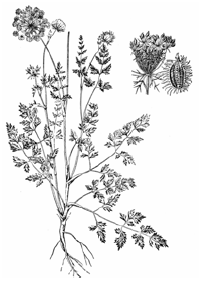
After a thorough visual examination of the collected specimens physical structure and botanical features, accumulating evidence suggests that this seed-producing wildflower plant is the wild carrot, Daucus carota. Daucus carota, a herb belonging to the Umbelliferae family, is one of many prevalent biennial plants to be found abundantly growing in Canada and around the world. Like cultivated carrots, wild carrots share a very similar morphology and anatomy except for characteristics of the root (Dale 1974).
The obtained plant has an approximate height of approximately 53 cm (from root tip to flower). This dicot possesses a small, semi-spindle shaped taproot that is whitish, slender, and hard, and having only a few lateral rootlets. The stems are erect and branched, rigid and covered with tiny prickles. The lanceolate leaves on the stem are positioned alternately and grow in opposite pairs; the lower leaves are larger than the upper, both of which have lobed margins, an acute leaf apex, and rounded leaf base. The leaves also have long petioles and the leaf type is pinnately compound. Furthermore, many white small flowers occur in a cluster where the individual stalks of each flower (each containing five petals) all rise to an umbel flower arrangement; however, no bright-red flower in the center was observed. Finally, the seed (not observed) produces a grayish-brown fruit that is slightly flattened, bearing bristles with numerous hooked spines in rows of five (Dale, 1974).
Wild carrots grow in ruderal and open habitats in many parts of the world (Hauser & Sang, 2007), such as prairies or meadows, pastures, areas along railroads and roadsides, and waste areas. The soil it grows in is characteristically sandy or gravelly and in wet areas, which is typically were one would find this widespread plant (Burrill & Fitzsimmons, 1999). In the Eastern parts of Canada, wild carrots are mainly adapted to soils containing a large amount of calcium carbonate from limestone rock called calcareous soils, but it is not limited to them (NWCB, 2007). In severally shaded areas, wild carrot is suspected to be a short-lived perennial, making it less vigorous and productive (Dale 1974). Moreover, wild carrots require a habitat that can provide more than 120 consecutive frost-free days to flower; in Canada, this is marked between mid-spring and late-summer. The plant occurs from sea level up to 1500 feet. Since wild carrots can survive in Central America, where day-length is relatively constant, and in Northern Sweden, were there are 24 hours of daylight in the summer, the plant, therefore, is not limited to photoperiods (Dale 1974).
Wild carrots are generally biennial wildflowers, signifying that the plant takes two years to complete its biological lifecycle. During the first year, the plant grows and produces leaves only. During the second year, the stem emerges and the plant produces flowers (late-June through August) and set seed. After flowering, the umbel closes and fruits (seeds) emerge with fine bristles that cling onto insects and animals – aiding in cross-pollination (OMAFRA, 2003). Lastly, the flowers produced by this plant are said to be complete, that is, it is a monoecious system with the stamens and pistils on the same plant.
Like the cultivated carrot, the wild carrot is to some degree, edible, even though the root quickly becomes difficult to consume due to its fibrous composition. Historically, wild carrot seeds were used as a natural contraceptive in women, and have been reported to possess antifertility activity (Chaudhury, 1966). In fact, in a study conducted by Garg & Garg (1971), aqueous seed extracts of this plant encouraged antifertility in female albino rats by disrupting the implantation process (Chaudhury, 1993). When female rats were treated with a combination of progesterone – a steroid hormone involved pregnancy – and wild carrot seed extract, a reverse effect was observed (Ahamed & Kaliwal, 1987), suggesting that the seed may block progesterone synthesis.
Interestingly, it is said that Queen Anne (Wife of King James) had pricked her finger with a needle and a single drop of blood dripped onto the flower when she was making a lace, resembling the red flower that grows in the middle. Also, since the wild carrot bears close resemblance to Water Hemlock – a highly poisonous Ontario wildflower – wild food gathering must be done with extreme caution. Although considered a noxious weed (USDA, 1997), Daucus carota is still appreciated by some due to its aesthetically pleasing appearance and used as a food and medicinal herb.
References
- Ahamed R.N., & Kaliwal B.B. (1987). Maintenance of implantation by progesterone in carrot seed (Daucus carota) extract treated albino rats. Indian Journal of Physical and Natural Sciences, A7: 10–14.
- Burrill L.C., & Fitzsimmons J.P. (1993). Wild Carrot. Extension Bulletin PNW 447.
- Chaudhury R. (1966). Plants with possible antifertility activity. Indian Council of Medical Research, New Delhi, 55.
- Chaudhury R. (1993). The quest for a herbal contraceptive. National Medical Journal of India, 6(5): 199–201.
- Dale, H.M. 1974. The biology of Canadian weeds. 5. Daucus carota. Canadian Journal of Plant Science 54:673–685.
- Garg G.P., & Gary S.K. (1971). Antifertility screening of plants: Part 7. Effect of five indigenous plants on early pregnancy in albino rats. Indian Journal of Medicine Research. 59(2): 302–306.
- Hauser T.P., & Sang I.S. (2007). Survival and flowering of hybrids between cultivated and wild carrots (Daucus carota) in Danish grasslands. Environmental Biosafety Research, 6(4): 237–247.
- NWCB: Noxious Weed Control Board. (2007). Wild Carrot: Daucus carota. Accessed: October 23, 2009, http://www.nwcb.wa.gov/weed_info/Daucus_carota%20.html.
- OMAFRA: Ontario Ministry of Agriculture Food & Rural Affairs. (2003). Ontario Weeds: Wild carrot. Accessed: October 23, 2009, http://www.omafra.gov.on.ca/english/crops/facts/ontweeds/wild_carrot.htm.
- USDA: United States Department of Agriculture. (1997). PLANTS Profile for Daucus carota. Accessed: October 23, 2009, http://plants.usda.gov/java/profile?symbol=DACA6.